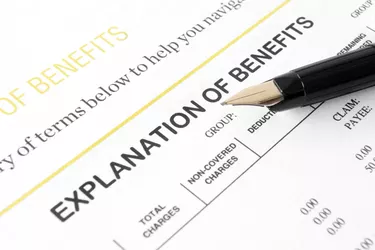
Hold onto the Explanation of Benefits (EOB) you receive after each visit for medical care. The insurance company sends an EOB as soon as a claim is submitted to them for your health care. It has essential information based on your insurance coverage that you can track each time you or one of your covered family members visit a doctor – and it can come in handy at tax time too.
Information an EOB Provides
Video of the Day
The EOB does just what its name implies: it provides an explanation of your health care benefits. When you receive service or medical equipment from a health care provider, the provider will submit a bill to the carrier of your health insurance plan to request payment.
Video of the Day
The EOB provides important details about your visit, such as claim number, policy number, patient account and what services were received and at what cost. It outlines what the provider expects the insurance company to pay. It also estimates your contribution, which is whatever portion of the bill is not a reimbursement through your insurance carrier. If you have a health savings account (HSA), this is an easy way to track how much of those funds are being used.
During the calendar year, it's wise to check these details against the actual services you received. By doing this, you can catch any instances where your copay wasn't properly documented or your health care service was coded incorrectly. These errors could cost you and the health insurance company, so it's good to check right when you receive the EOB.
You can always keep paper copies of your EOBs in a file, but if you choose paperless billing, you may be tracking all of your health insurance expenses in the online portal of your insurance company.
Holding on to your EOBs can also help you track and manage your progress toward meeting your health plan's deductible and total out-of-pocket expenses throughout the year.
It's a good idea to retain EOBs for this purpose for at least one year after a medical claim has been fully paid to compare for accuracy.
Consider also: How Long to Keep Income Tax Records
EOBs at Tax Time
If you have eligible expenses for health care services that you intend to deduct on your federal tax return, the EOB can help you track costs and services so you can itemize and provide proof to the IRS that your care was a qualified medical expense.
To know exactly which expenses you can deduct and how much of them you can deduct, go straight to the IRS guide: Publication 502: Medical and Dental Expenses.
If you have enough medical expenses to file for a tax deduction, keep those EOBs for up to seven years past the tax year in which they were claimed. The IRS has six years to come back and ask you for that proof.
What EOBs Help You Prove
If you want to see if itemizing your deduction will get you a better tax break than taking the standard deduction, you'll need an accurate account of how much you spent. The IRS allows you to deduct only the amount of medical and dental expenses that exceed 7.5 percent of your adjusted gross income (AGI).
For instance, if you are filing separately and have an income of $50,000 after all adjustments, you can claim any expenses over $3,750. If you have significant medical expenses that make your out-of-pocket expenses tally over the standard deduction for filing as head of household, $18,800, this is when itemization will benefit you. And your records have to be precise.
If, in tracking your expenses and premiums, you find you are unable to make ends meet, check irs.gov or other consumer-focused organizations, like FamiliesUSA.org. You may qualify for the premium tax credit or other assistance to make health care affordable.
Consider also: When to Consult with a Tax Professional
Tracking Health Plan EOBs
You can always keep paper copies of your EOBs in a file, but if you choose paperless billing, you may be tracking all of your health insurance expenses in the online portal of your insurance company.
If that is the case, you may be able to download your EOB (and other claim-related information) right from that portal and import it into a spreadsheet. If easy export isn't available, you can set up your own spreadsheet with the fields you need.
As you receive an EOB, enter the amounts onto the spreadsheet and save the original document. This will allow you to do easy calculations for income taxes at year's end.
Consider also: How to Find Out My Medical Identification Number
- Cigna: Understanding Your Explanation of Benefits (EOB)
- United Healthcare: What Is an EOB and Why Do I Need It?
- National Association of Productivity and Organizing Professionals (NAPO): How Long Should I Keep Explanations of Benefits from Medicare and Health Insurance Companies?
- Patient Advocate Foundation : If It Is Not a Bill, Why Is the EOB Important to Me?
- IRS: Publication 502 - Medical and Dental Expenses
- IRS: IRS Provides Tax Inflation Adjustments for Tax Year 2021